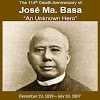In several instances, I read some complaints in the social media about the water supply and quality in Bacolod City. In particular, some residents are complaining that the water supply in their areas is quite erratic, while the water coming out from the faucets is no longer colorless.
The Bacolod City Water District, being the major water service provider of the city, should address these issues. The concern on water goes beyond the delivery and quality, because it is necessary that we should look into the very sources of supply. This is particularly important since economic activities and opportunities are getting more bustling in Bacolod.
The main sources of water in Bacolod are the Boro-boro and Bocal Springs in Barangay Alangilan and the deep wells and artesian wells scattered in the different areas. The last two sources extract groundwater to supply the water needs of various households and commercial and industrial establishments. The water from springs emanate from the Upper Caliban-Imbang Watershed, formerly known as the Baciwa Watershed.
I don’t have the exact figure right now to determine the volume of water coming from each source of water supply in Bacolod City, but I guess, the Boro-boro and Bocal Springs account for a considerable capacity.
It should be noted that Bacolod itself has basically no watershed within its area of coverage. Based on its elevation and slope, Bacolod is generally a level area with slight slope of an average of 0.90 percent only, and has a maximum altitude of about 10 meters above sea level. I am not sure with this kind of physical attributes if Bacolod has classified forestlands.
The Food and Agriculture Organization of the United Nations defines watershed as a topographically-delineated area that is drained by a stream system. Catchment is often used as a synonym for watershed, according to FAO.
The Upper Caliban-Imbang Watershed, where the water supply of Bacolod is derived, straddles Murcia town and Talisay City, and is within the Northern Negros Natural Park. While it is true that watershed does not recognize political boundaries and the natural system and flow of water may not at all be permanently altered, it is a given fact that some local government units are benefitting from the natural resources, such as water, with main sources from other LGUs, like the watershed of Bacolod.
It is by this reason that the Baciwa is investing some funds for the protection and rehabilitation of the Upper Caliban-Imbang Watershed, in partnership with the Negros Forest and Ecological Foundation Inc., and local community organizations in the area. However, while the initiatives have been ongoing for quite a good number of years, there is still so much to do in ensuring the continuing supply of water from this very important watershed of Bacolod.
Very recently, there were reports of illegal cutting, forest clearing and occupancy in this watershed.
The ground water extraction is not sustainable in the long run if the recharge that comes from the rain and watershed is not sufficient enough. This is really problematic, especially during the occurrence of El Niño, or prolonged dry season. Groundwater is also susceptible to contamination from toxic and other polluting substances that may pose hazard and danger to health.
In addition, excessive exploitation of groundwater may destabilize the land’s undersurface structure that may further trigger saltwater intrusion. It is therefore necessary that the planning for water resources and supply should be integrated into local development planning and priorities, in support with the initiatives of the water service provider.
Bacolod residents have the responsibility as well to participate in the protection and conservation of areas where their water sources are coming, and that is the Upper Caliban-Imbang Watershed in particular, and the Northern Negros Natural Park, in general.*









0 Comments